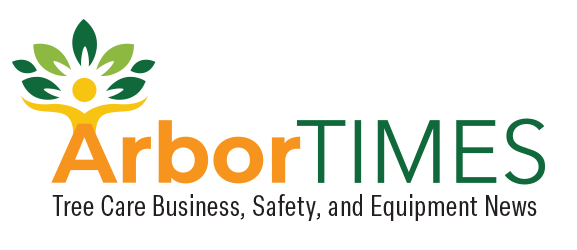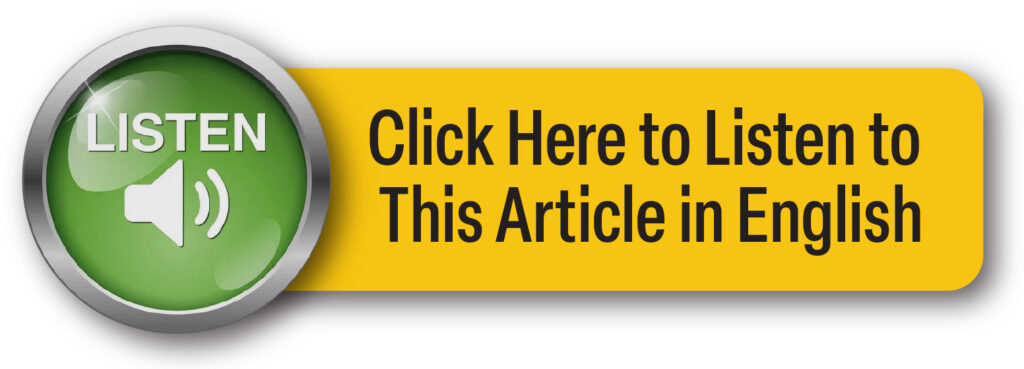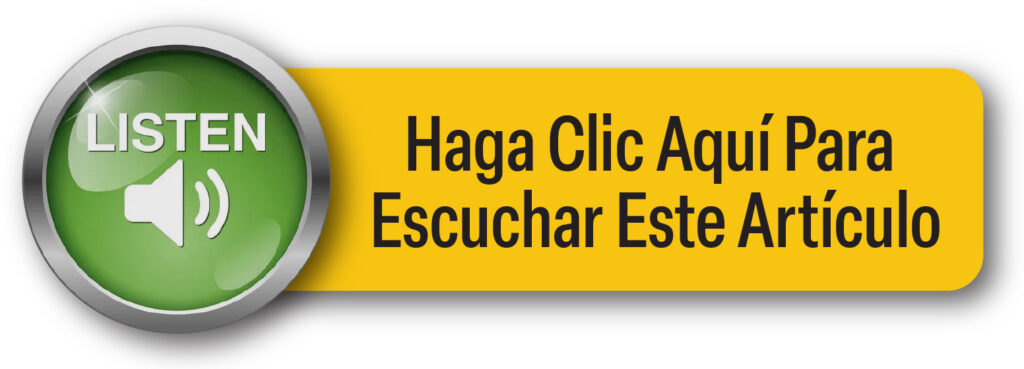Too Hot to Handle
Mitigating the dangers of heat-related illnesses on the job site
Este es nuestro intento de convertir las historias en audio español usando Inteligencia Artificial. Aún así le recomendamos que reconfirme ciertas palabras clave y temas. ArborTIMES no garantiza ni se responsabiliza de la conversión del inglés al español de los relatos.
.
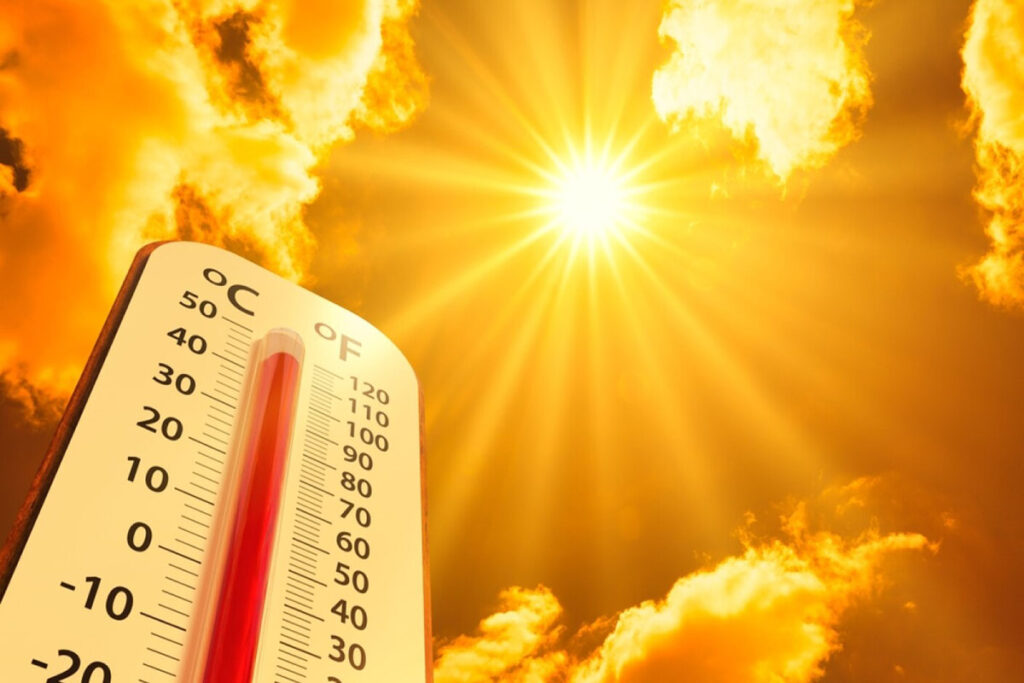
Summer is here, which means working outside in direct sunlight and heat for extended periods increases the risk of heat-related illnesses on the job. Similar to securing equipment and following safety procedures, it’s essential to do the same with your health.
Approximately 1,220 people die annually in the U.S. from extreme heat, according to the Centers for Disease Control and Prevention. There are quite a few common heated-related injuries and illnesses you can experience in the tree care industry, and the key to avoiding them is knowing how to recognize risk factors and early symptoms at the job site.
Understanding Heat-Related Illness
Heat-related illness, also known as hyperthermia, can present itself with many different symptoms and require different treatments. That’s why it’s important to recognize the symptoms so that the right treatment can be started immediately. Heat-related illnesses are serious and can range from mild symptoms like headaches to more severe symptoms like seizures, coma, and even death.
Hyperthermia – the opposite of hypothermia – occurs when the body gets too warm. Typically, normal body temperature tends to be around 98.6 degrees Fahrenheit, though it can sometimes be a bit higher or lower, varying from person to person. Once body temperature reaches 99 and above, this is considered too warm and may indicate hyperthermia.
Of all the heat-related illnesses, the most severe is heat stroke, which can lead to serious and sometimes fatal complications. In early stages, heat-related illnesses can be easy to remedy, but it’s important to be vigilant and know the warning signs of each condition.

Heat Cramps
The first level of heat-related illness tree workers can experience are heat cramps, which are a sign that your body is starting to get too hot. Symptoms include painful muscle spasms or tightening of the muscles that occur in places like your:
- Abdomen (belly)
- Arms
- Hands
- Feet
- Legs
- Rib cage
- Shoulders
Heat cramps are caused by a loss of electrolytes in the body (salt and nutrients) through excessive sweating.
We’ve been taught from a young age to drink water when it’s hot and you’re sweating. However, this is two-fold. Drinking too much water during very hot conditions, combined with excessive sweating, means you’re flushing out those electrolytes faster than taking them in.
As your body temperature rises, some changes occur. Unlike a normal fever, where the brain’s hypothalamus increases your body’s set-point temperature, your brain does not intentionally increase your body’s temperature. Instead, you’ll start experiencing symptoms like heat cramps as your temperature rises.
Another side effect of excessive sweating due to heat is heat rashes, which often accompany heat cramps.
These rashes will look like small pimples or red blisters and typically form in areas like the crease of your elbow, under your breasts, on the upper chest and neck, as well as the groin area. Clammy skin, dizziness, weakness, and extreme sweating can accompany heat cramps.
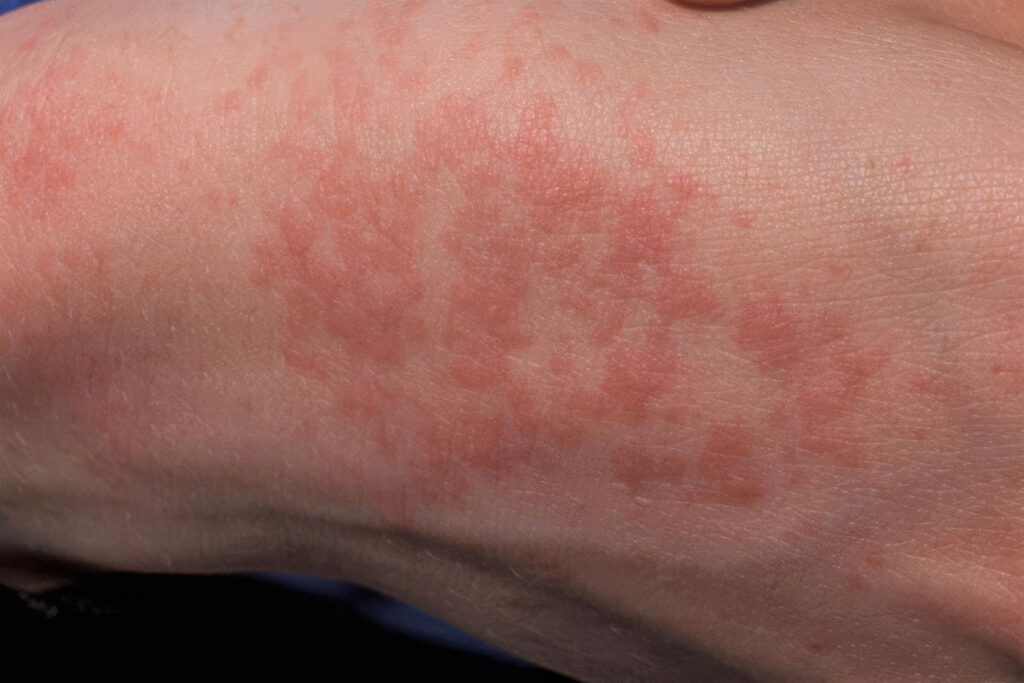
Heat Exhaustion
The next level of heat-related illness is heat exhaustion, which occurs when the body heats up too much and is unable to cool itself down.
Unlike heat cramps, symptoms for heat exhaustion can range from mild to severe. Like heat cramps, the number one cause of heat exhaustion is dehydration, because your body has not replaced the electrolytes lost during periods of excessive sweating.
Symptoms of heat exhaustion can include nausea, vomiting, diarrhea, headaches, fatigue, feeling faint and weakness. Other lesser-known symptoms of heat exhaustion can be pale and moist skin. If you notice someone working in extreme heat looking pale and clammy, this indicates that something serious is going on.
Failure to treat heat exhaustion in a timely manner may cause permanent damage to organs and even death.

Heat Stroke
The most serious of the three heat- related illnesses is heat stroke. This happens when the body temperature rises dramatically above 104 degrees Fahrenheit and can be a deadly condition.
There are two different types of heat stroke: exertional heatstroke and non- exertional heatstroke. Tree care workers are most likely to experience exertional heatstroke caused by physical overexertion in hot and humid conditions.
The symptoms of heat stroke are much more severe and indicate later stages of heat stroke. If a worker is suffering from any of them, they need to call 911 for help immediately.
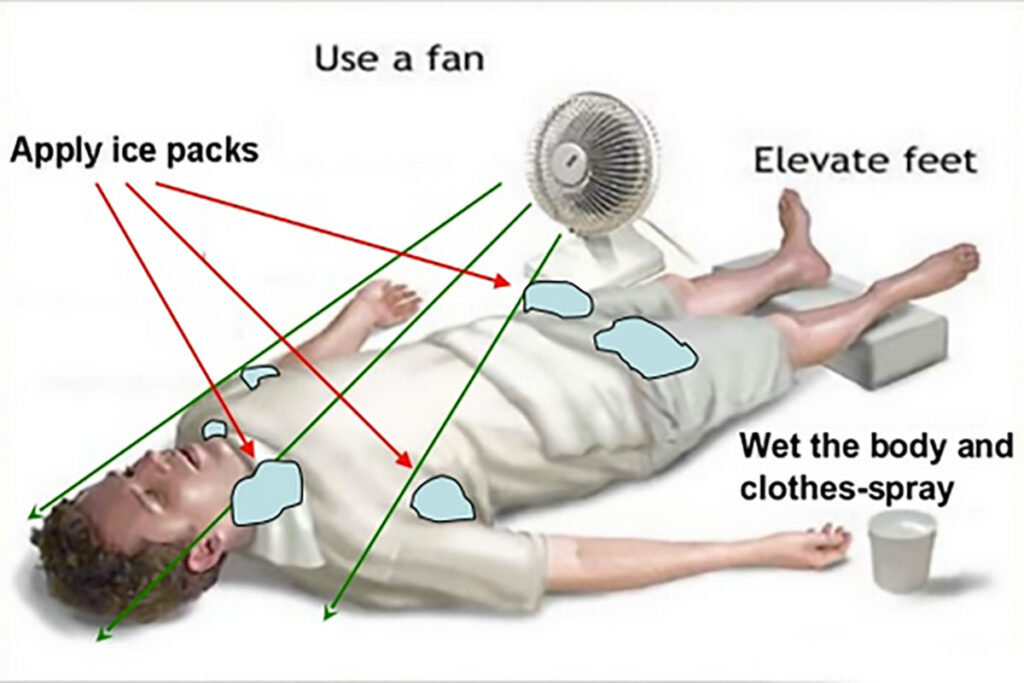
Symptoms include:
- Anhidrosis (dry skin with no sweating)
- Ataxia (problems with movement)
- Balance problems
- Dizziness
- Excessive sweating after you have stopped all exercise or labor
- Hot, flushed skin
- Pale skin
- Low or high blood pressure
- Nausea and vomiting
- Crackling in the lungs
- Oliguria (low urine)
- Tachycardia (increased heart rate)
- Fainting
- Seizures
- Weakness
Heat stroke can cause serious complications, such as brain swelling, organ failure, nerve damage, circulatory problems, and metabolic dysfunction.
Treatment of Heat-Related Illness
Treatment for early-stage heat-related illnesses can start with simple things, such as moving to a cooler location, getting out of the sunlight, or seeking medical treatment. If you’re experiencing heat cramps and heat exhaustion while you’re working, you need to move to a cool place to rest.
Keep your body cool by removing excess clothing and placing damp, cool cloths on the neck and head, and make sure you are drinking liquids with added electrolytes, like a sports drink. If your body is cramping, try to stretch out those areas to relieve the cramps.

For more serious symptoms, head to a hospital to test your temperature and check for organ dysfunctions while also doing a complete blood count and other medical tests. You should seek medical attention within 30 minutes of experiencing mild to severe symptoms. In the hospital, doctors will likely give you fluids intravenously and other medication to combat the symptoms.
Typically, the treatment for heat cramps, heat rash, and heat exhaustion happens quite rapidly after arriving at a medical center. This is because your body desperately needs to cool down and replenish electrolytes.
For heat stroke, recovery can take longer, from a few days to a week, depending on how severe your symptoms are. If you have long-term complications, like acute respiratory distress
syndrome or renal failure, the road to recovery will likely be longer, making it difficult for you to return to work.
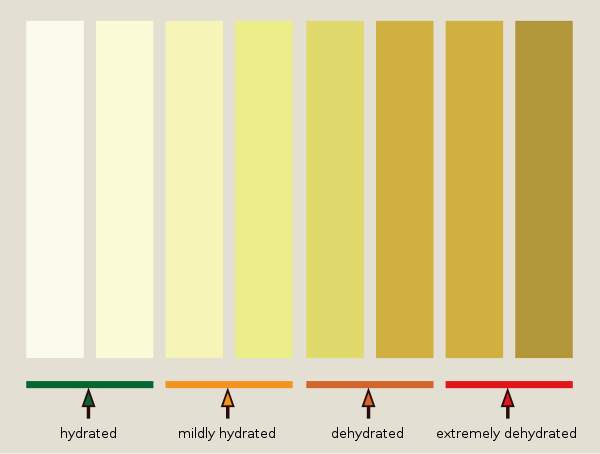
Risk Factors
Working on trees, especially up in trees, can be physically taxing and can take its toll while in the heat. Some people are more at risk for developing a heat-related illness than others.
Taking certain medications can also increase your risk of a heat-related illness, according to the US Department of Health and Human Services.

These include diuretic pills, also known as water pills, antihistamine medications for allergies, and antipsychotic medicine used for neurological illnesses. These medications can impair the body’s natural ability to cool itself down, which can be dangerous when performing intensive physical labor in the heat.
Other risk factors include:
- Poor physical fitness
- Using drugs or excessive alcohol
- Lack of experience working in the heat
- Not taking frequent enough breaks
- Wearing very heavy, thick, or dark clothing
- Age
- Gender: men are more likely to suffer from a heat-related injury than women
- History of a heart-related illness
Preventing Heat-related Illness
The best way to prevent heat-related illness is to get out of the heat and rest somewhere cool for a short period. Wearing the right personal protective equipment (PPE) can also help. And for situations where you can’t stop working, a cold compress to your skin can help.
Drinking electrolyte-infused fluids can help replenish all the nutrients lost from sweat. If you’re drinking cold water, it may be tempting to guzzle it down, but it’s important to slow down and take small sips. Drinking too much water all at once just flushes out the nutrients in your body faster.

Protection Plans
How to implement a protocol in accordance with OSHA standards
By Korey Conry, Field Safety Supervisor, Mountain F Enterprises
To maintain the well-being of employees during high heat conditions, companies are required to implement heat illness protection plans.
These plans not only ensure compliance with federal standards laid out by the Occupational Safety and Health Administration (OSHA) but also obey additional rigorous guidelines set by other states. With temperatures on the rise this time of year, the importance of these protocols cannot be overstated.
Understanding the Risks
Arborists, construction workers, agricultural laborers, and other outdoor maintenance crews are particularly vulnerable to heat-related illnesses due to prolonged exposure to high temperatures. Factors such as high humidity, direct sunlight, and demanding physical activity can worsen these risks even further.
OSHA Regulations
OSHA has recognized standards to protect workers from heat-related hazards. These guidelines point out the importance of employers providing access to water, rest breaks, and a shaded area.
Also, employers must use an acclimation system for workers in hot or new environments to gradually build up and train them to recognize the symptoms of heat-related illnesses.
According to OSHA, employers must develop a Heat Illness Prevention Plan modified to their specific worksite conditions. This plan should include procedures for monitoring workers’ conditions, responding to signs of distress promptly, and ensuring emergency medical services are immediately available, if needed.
Regular training sessions are important to educate workers on preventive measures and emergency protocols or to have an emergency action plan in place.
State Requirements
Some states have additional standards to protect workers. For example, the California Division of Occupational Safety and Health (Cal/OSHA) is one of the strictest state regulatory bodies regarding heat illness prevention.
The organization imposes additional obligations on employers in the state, going beyond the federal requirements and mandating specific measures to protect workers from heat-related risks.
Under Cal/OSHA regulations, employers must provide cool drinking water to workers at no cost and always have access to shade whenever temperatures exceed a certain threshold. The shade must be enough to accommodate all employees on meal breaks or breaks in between meals.
Also, employers are required to implement high-heat procedures, which include closely monitoring employees for signs of heat illness and implementing additional preventive measures when temperatures soar.
Implementation Challenges
Despite the clear regulatory framework established by OSHA and Cal/OSHA, implementing effective heat illness prevention plans can be very difficult for employers.
In industries where outdoor work is unavoidable, such as tree work, ensuring accordance with heat safety regulations while maintaining productivity can be a hard balance.
One of the main challenges is changing workplace culture and attitudes toward heat safety. In a lot of cases, workers and climbers may resist taking adequate breaks or wearing protective gear, fearing it could slow down their production numbers or that the crew could be perceived as not being tough enough.
Employers must keep education and training to overcome these stereotypes and adopt a culture of prioritizing the long-term employment with the company.
Best Practices
Several best practices can help employers mitigate the risks associated with heat-related illnesses while complying with OSHA and Cal/OSHA standards. These include:
- Risk assessment Conducting thorough risk assessments to identify potential heat hazards in the workplace
- Engineering controls Implementing engineering controls such as shade structures to reduce heat exposure
- Workplace modifications Adjusting work schedules to avoid the hottest parts of the day or rotating workers between climbing and groundmen tasks
- Personal protective equipment (PPE) Providing appropriate PPE, including lightweight, breathable clothing, hard hats, and sunscreen
- Training and education Conducting regular training sessions to educate workers on recognizing the symptoms of heat- related illnesses and the importance of hydration and rest breaks
- Monitoring and supervision Applying protocols for monitoring workers’ conditions and ensuring supervisors are trained to recognize signs of distress and respond effectively
As temperatures continue to rise, protecting outdoor workers from heat-related illnesses becomes gradually critical. OSHA and Cal/OSHA have established comprehensive regulations to guide employers in developing tough heat illness protection plans.
By making employee safety, implementing preventive measures, and raising a culture of awareness, companies can ensure compliance with regulatory standards while safeguarding the well-being of their workforce.
Heat illness prevention isn’t just about following regulations; it’s about caring for the health and safety of those who keep our industries running.
Korey Conry is a field safety supervisor and trainer at Mountain F Enterprises. A Utility Arborist through ISA, TCIA Instructor, Flagger Instructor, CPR Instructor, and OSHA authorized trainer. He teaches a five-week utility arborist course in California at Butte College.
